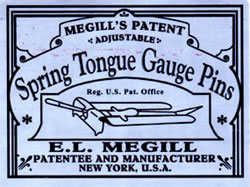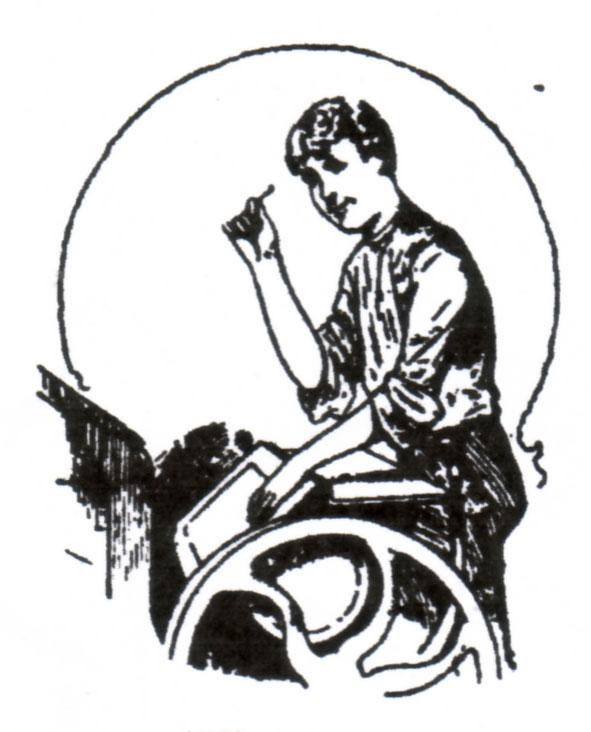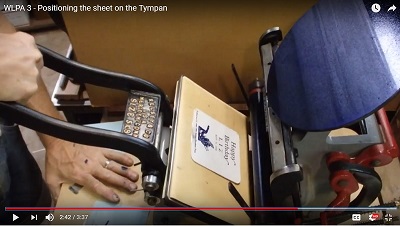
Megill's
Spring Tongue Gauge Pin ~ Megill Double Grip
Gauge Pin
~
~ Megill Extension Feed Guides ~ Larsen Quad Guides ~ Megill's Flexible Gauge Pin w/ wings - cannot be crushed by photo polymer base! Instructions & Hints on using the Flexible or Spring Tongue Gauge Pins Megill's Perfect Register Gauge ~~~~~~~~~~~~~~~~~ OTHER GAUGE PINS The New Excelsior Cushion Quad Guide BASIC Press works subjects: GAUGE PINS Gauge Pins are used to hold the sheet in place as the platen closes and meets the type form. Some folks cut slits in their tympans or make 'paper guides' out of folded or taped card stock, some early printers would glue 10 or 12pt 3-em quads to their tympan, then affix a small piece of card stock to the top to hold the sheet against the platen. But hand-made glued quads or paper gauges are hard to position and nearly impossible to adjust. To print squarely on the sheet, or to register two color jobs, Gauge Pins offer advantages in both time and accuracy. Edwin Megill was the most prolific developer and manufacturer of gauge pins from the time he began in 1869 - 140 years before this web page was published. The Edward L.
Megill Company, Brooklyn, NY
As you can see from the advertisement below, Edward L. Megill specialized in designing and manufacturing gauge pins - clever little devices used to hold paper in place - in a very specific place - as it is being printed on a platen press. The advertising flier below illustrates a wide variety of various gauge pins designed and manufactured by Edward Megill - and later, his son Alfred L. Megill - over the years. The label illustration further down shows a Spring Tongue Gauge Pin inserted into the typman of a platen press. "Attached
to tympan, adjusted to position, teeth
forced down and tongue over margin"
Sometimes
- and particularly when doing a longer
run - or feeding a heavy card stock
which may tend to force the pin from
it's locked position, press operators
will drip a few drops of sealing wax
onto the pin - to fasten it more
securely to the tympan sheet.
Of particular interest in this advertisement are:

 While perhaps not the easiest or best style gauge pin to use, there is no question that Megill's patented Spring Tongue Gauge Pins have been and still are - for well over one hundred years - the most common gauge pins in use throughout the United States. Some printer go through their entire careers using only Spring Tongue Gauge Pins as shown above. Some of the gauge pins shown on the flier are still being manufactured using Mr. Megill's own patented machine - which he designed during the late 1800s. This machine was purchased from Edward Megill's son Alfred Megill (in 1969?) by what was then the American Wood Type Company, which has evolved into the American Printing Equipment Company. These gauge pins are available from a variety of sources, including The Excelsior Press - and are included as part of the Small Press Starter Kit Megill's Double Grip
Gauge
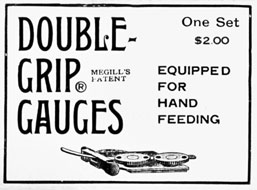 But Mr. Megill did not stop with the
Spring Tongue Gauge Pin - not by a long shot.
Competing with Mr. Larsen's
popular Quad Guides*,
Megill announced an improved gauge pin design which
the company patented in 1924. But Mr. Megill did not stop with the
Spring Tongue Gauge Pin - not by a long shot.
Competing with Mr. Larsen's
popular Quad Guides*,
Megill announced an improved gauge pin design which
the company patented in 1924. The Improved Double Grip Gauge - also still in use and available today- at about five times the price of the simple Spring Tongue model. But this gauge pin gives the platen press operator a more flexible adjustment mechanism - along with a "double grip" screw set which clamps the gauge pin tightly to the platen. The operator cuts a vertical slit into the tympan top sheet, slips the base of the pin unit under the packing, then tightens the thumb screws to clamp the pin tightly to the sheet. The main advantage of this style of pin is in the ease of adjusting it's position - repeatedly, until the right position is found and the pin can be tightly clamped to the tympan, giving the feeder firm quides to feed against - guides which can be locked even tighter with the use of the included "key". No sealing wax is needed, no pins pierce the packing. A slit is cut and the pin can be moved up and down without wearing out the paper under its position, as can happen with the simpler and less expensive spring tongue style described above. 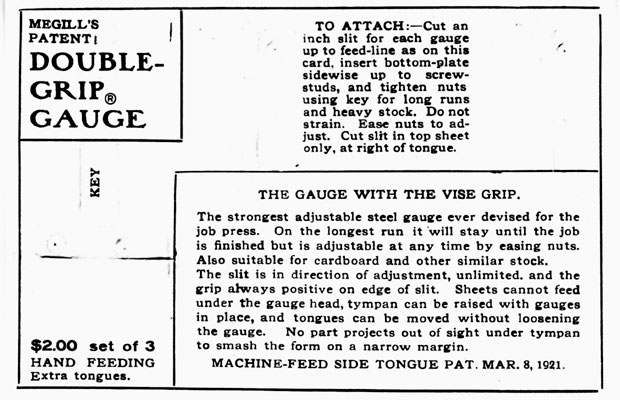 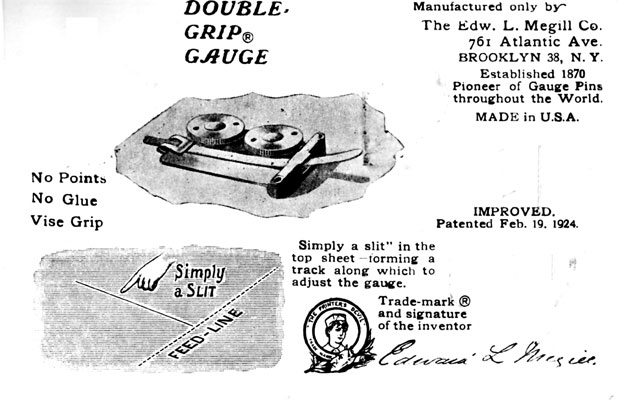 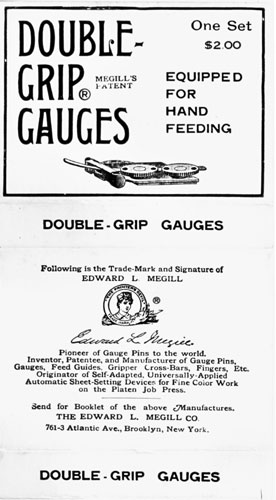 Megill's Flexible Feed
Gauges A 100-year old gauge pin re-surfaces
as the paper guide for today's Photo-polymer
plate base printer.
This rather uncommon and unique gauge pin solves a common problem for many new printers. We now stock and supply letterpress printers with this unique and excellent gauge pin. The Megill Flexible gauge pin is particularly useful for printers who mount photopolymer plates on Boxcar Base or the Excelsior Chase-Base. Any base would crush normal gauge pins - but no the 1-point-thick Megill Flexible Gauge Pin.  This is
Megill's virtually flat Flexible Feed Guide as can be
see here. This pin is only one-point thick - low
enough to position anywhere safely - under a depressed
gripper or with an Excelsior Chase-Base or the popular
Boxcar Base. This is
Megill's virtually flat Flexible Feed Guide as can be
see here. This pin is only one-point thick - low
enough to position anywhere safely - under a depressed
gripper or with an Excelsior Chase-Base or the popular
Boxcar Base. These pins work perfectly under both the Boxcar Base and our Excelsior Chase-Base. And, better than that, we have found a stash - a not-quite-unlimited supply, but enough that we are stocking 4 dozen - soon to be 100 - at a time. See The Fundraising Page to purchase.  Instructions: To mount these Flexible gauge pins on your top tympan sheet, you must stab it through the top sheet about 1/8" below the line where your sheet will fall. Then slide the blade beneath the paper and bring the tip back up and out of the top sheet. This will set it lightly in place and you can pull a proof and begin adjusting position. Once the pin is in position, tap it gently at the cross of the "T" to stab the pins through the top sheet of your typman. If you are running a large, heavy sheet - like a file folder, for example - on a larger 8x12 or 10x15 press, you may find it helpful to set a second pin on the left side. Otherwise the weight of the paper may force the pin out of position. A second pin can minimize this problem if it occurs. Megill's Extension Feed Guides For extending the capacity of your platen. Now here's something every small press user should not be without - Megill's Extension Feed Guides actually increase the usable area of your platen by allowing you to set your lower guides as much as 1 1/4" below the lower edge of the platen. And we do have these in stock. See the Fundraising Page to purchase some for yourself - or as a gift to your favorite small press printer. 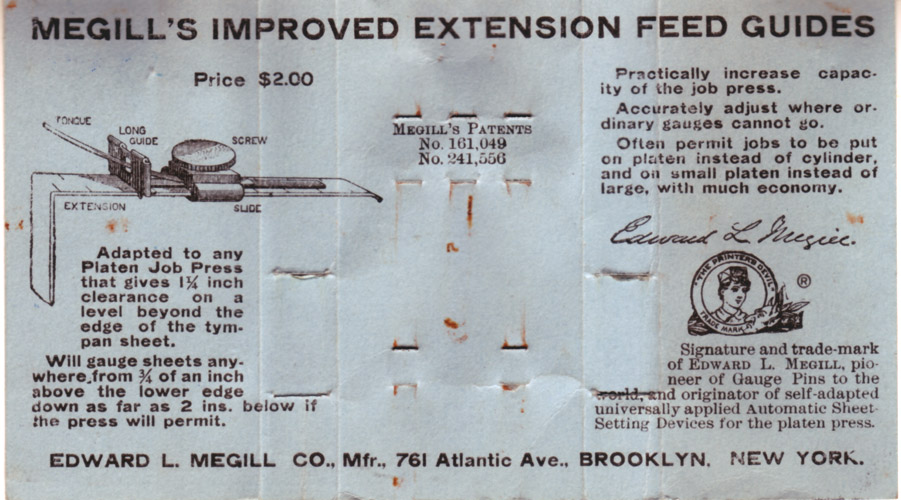   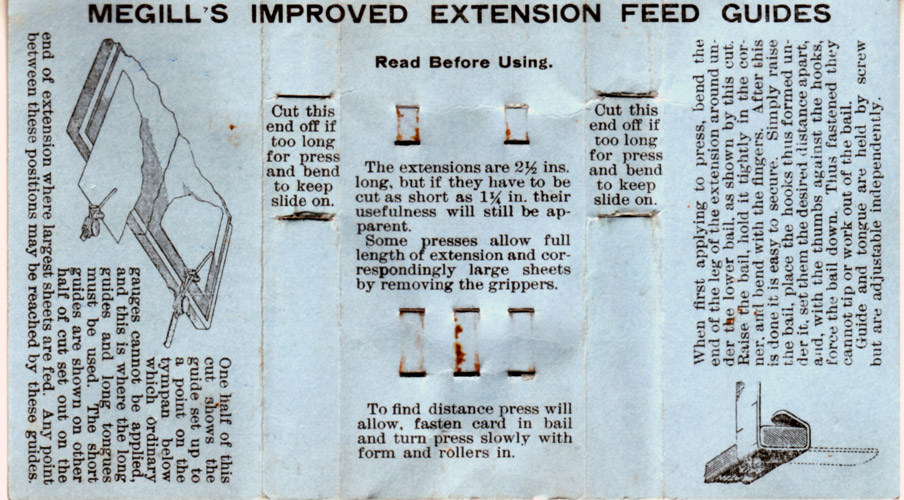 NEW! January, 2011 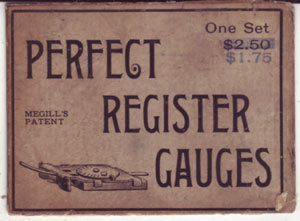 Now, here's something very exciting. Now, here's something very exciting. We have found and acquired for our collection, a full, working set of three of Edward Megill's Perfect Register Gauges This is something very, very special - something many of today's printers have discussed as "a good idea - I wish we had gauge pins that could be more easily adjusted." Well, we once did. 120 years ago, Edwin Megill came to our rescue and invented a very convenient and easily adjustable gauge pin. Dates stamped on the pins we have indicate patent dates of March 31, and April 7, 1891. Unfortunately - and until now - even common knowledge of the existence of this gauge pin has been lost. Perhaps some old printers had heard of them, but no one I had spoken to in the past 50 years ever implied that they had ever existed. There may be some more out there some where in Letterpress Land, but I sure don't know of them. If you do, please please let me know. A curious note about this addition to our collection - these gauge pins were found in Flemington, NJ - only ten miles from the location of the Excelsior Press Museum! 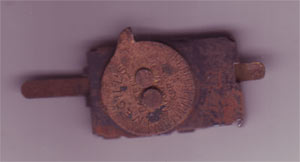 This
gauge pin is glued to the tympan -
approximately where you suspect the pin should be
placed. This
gauge pin is glued to the tympan -
approximately where you suspect the pin should be
placed. But, once in place, this Perfect Register Gauge can be adjusted up or down a few points - by simply moving the tang on the upper cam - to allow for Perfect Register of each card you print. The Perfect Register Gauge is the ideal solution for tight-register, multi-color work, in which aligning subsequent colors is always a challenge. click the image above for a close-up view. The photo may look a bit rough, but the cam moves smoothly, so these pins should still work as designed - 120 years ago. 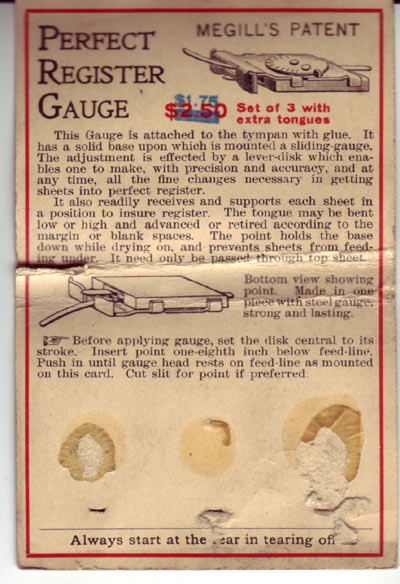 The sheet at the left includes complete instructions on how to use this pin on your press. As you can see, the price was dropped from $2.50/set to $1.75/ set after these cards were printed. Perhaps they were not well received by job printers who were experienced using the less expensive pins and did not feel a need for such a device. 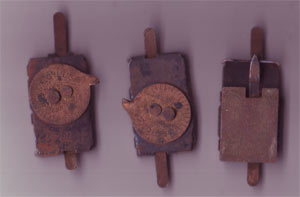 But today's printers simply don't have time to gain the experience of the typical printer of 100 years ago. For them, it seems that this perfect register gauge pin would be a boon. Below is an
advertisement and price list this that came with
these pins...
Note the strange graphic image. We had not see such an image on any other Megill literature. What year was such a graphic design in style???? (Note: the Double Grip Gauge shown on this sheet was patented in 1924) 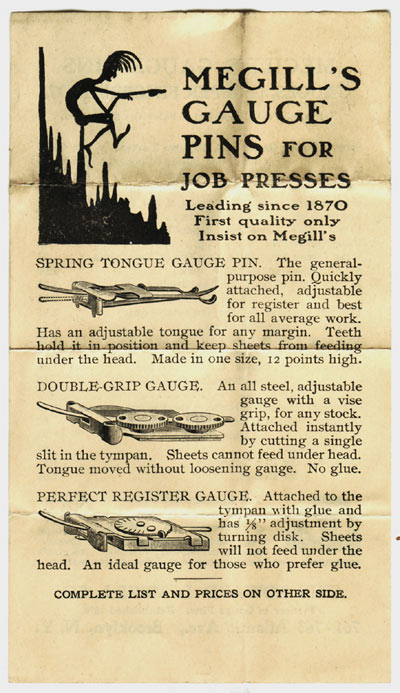
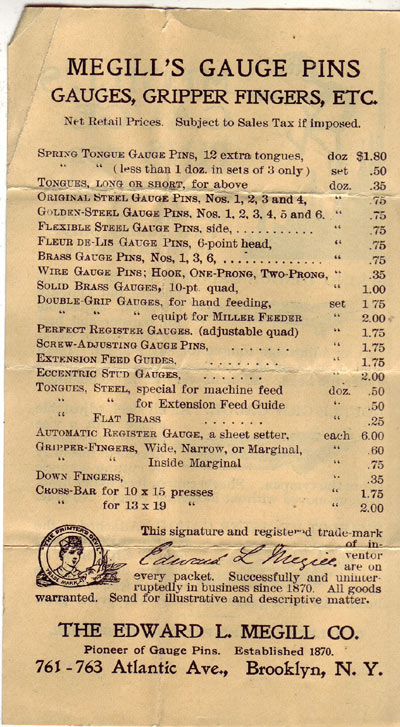 I'm sorry that we don't have any of these to share with other printers - YET - but if we can come up with a source - or figure out how to make some, we will... Note: Thanks to Edward Megill's grand-daughter (Alfred Megill's daughter) Charlotte for important updates to this brief history. 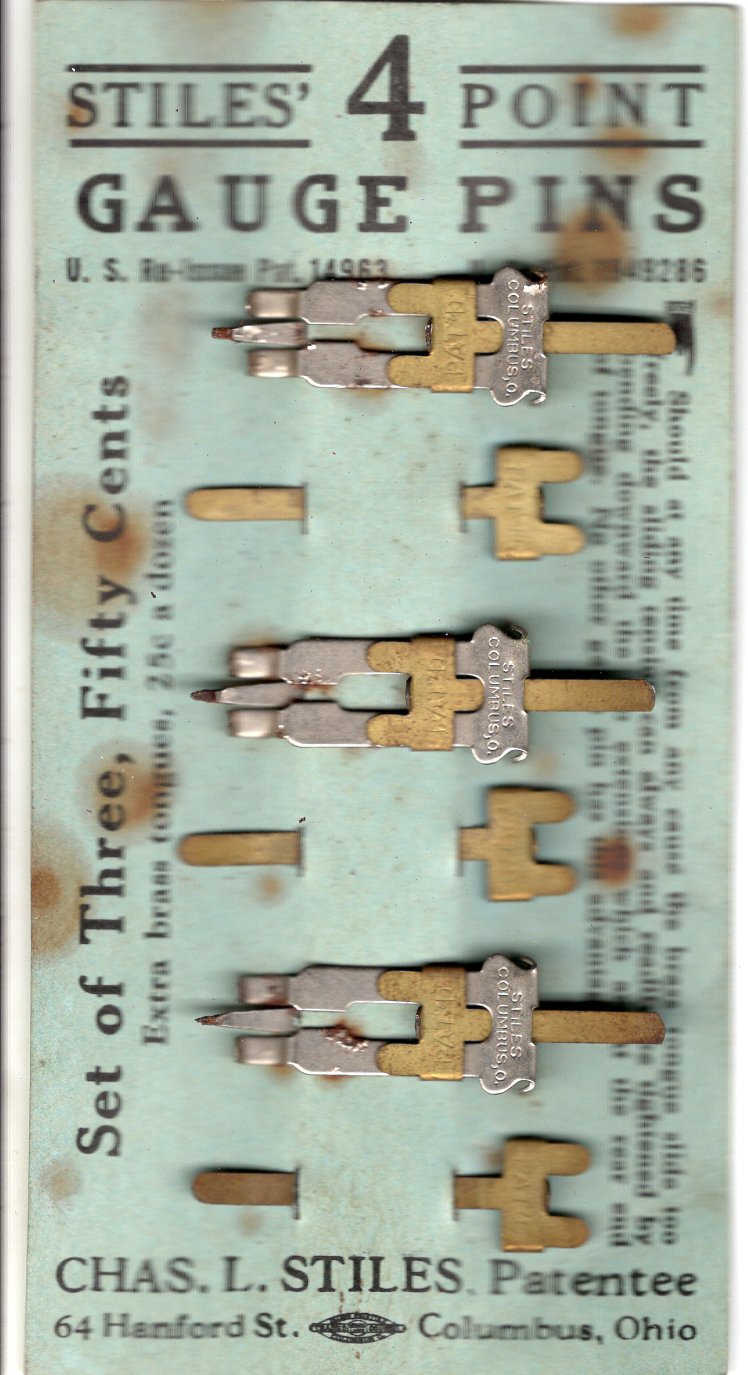 OTHER GAUGE PINS: OTHER GAUGE PINS:Stiles 4 Point Gauge Pins - Just found this new old stock package of a clone of the Megill Spring style Tongue Gauge Pins - the Stiles Gauge Pin, were patented by Chas. L. Stiles and made on Hanford Street in Columbus, Ohio. They look pretty much like the Megill's, are packed as a Set of Three and sold for $.50/3 at one time... patent numbers: U.S.Pat. 1949286 with a re-issue Pat. 14963 These were found in the bottom of a small box of "stuff" that came out of a shop that was most active during the 1930's & 40's. Larsen Quad Guides Another popular gauge pin, also still in use today, is the Larsen Quad Guide. Although copied by other manufacturers and available under other names (aka KORT - available from NA Graphics), the Larsen Quad Guide is number three in this list of what I believe are the most popular gauge pins in use today. The Larsen Quad Guide is based upon the old technique of gluing a 10 or 12 point 2-em or 3-em quad to the packing, with a small piece of cardboard glued to the top. While only minimally adjustable, the idea of gluing tabs onto a platen is still with us today. The Larsen Quad guide uses a spring clamp and 3 rows of small teeth on the upper part, to literally clamp the guide into place when slipped through a slit in the tympan. These guides are adjustable about 18 points in either direction and are very firm. The Excelsior Cushion Quad Guide It's Compressible Back to Fundraising Page $12/dozen 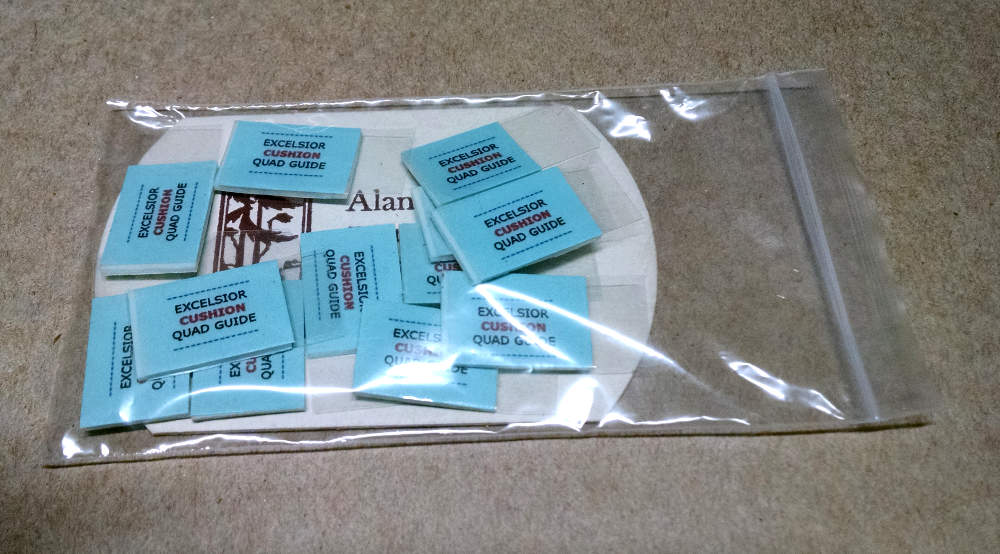 Excelsior Cushion Quad Guides - Compressible for Photo-Polymer Plate Printing This is a paper guide made here at the Excelsior Press Restoration Workshop, so we are never out of stock. We use double-stick foam tape with small pieces of clear mylar attached to one side. The other side is stuck to your tympan - in a carefully and precisely selected location. The paper slides up to the base of the guide and the mylar overhang keeps it there. Although you can move them a bit - when used on a mylar top sheet sheet - we can't promise that they are easily adjustable or reliably re-usable on tympan paper like Megill's steel pin or clamp products are. And, although ours can often be re-used, they cannot be assumed to be "reusable", since they rely on the adhesive to stay in place. Once it gets dirty or is covered with paper fibers and fails to hold tightly, it's no longer usable. But they are great for one time use and cost so little that replacing three for each new makeready should not be cost-prohibitive. Plus, if you're really cheap, or creative, or in a jam, you can make them yourself. They are called "Quad Guides" because in the old days of letterpress, printers would glue 12 point 3-em quads to their tympan sheet in postion, then glue small strips of tag or index to the top of the quad. This is how printers guided their sheets into position for printing. It was common practice until Edward Megill came along with his amazing selection of other types of re-usable and adjustable Gauge Pins. We've made these for years - as have many printers. For general work, we would use pieces of chipboard and tag to make up a paper guide like this. But, with the advent of photo-polymer plates - and the shallow draft of the relief image, we began using double-stick foam mounting tape. We made them and we sold them for many years... but without a fancy name. Now they have a name... We make ours pretty much the same way as has been done for a hundred years, except that we call these paper guides Cushion Quad Guides because instead of using hard type metal, we use soft, compressible cushion material. It works great, and they cannot be crushed. It's compressible... And, instead of using glue to adhere the guide to the tympan, we use adhesive the that is already on the compressible foam material. This makes them an ideal choice for small presses with cramped tympan areas or for use with photo-polymer mounting bases - whether one of ours or like the ones sold by Box Car Press and others, since, like the now rare Megill Flexible Gauge Pin, they cannot be crushed. The Mini Paper Guide the same thing, only smaller for better fit on 3x5 & smaller presses with their even more limited access to the tympan. They are the *only* paper guide to use on Baltimores and Sigwalts or the Kelsey Junior or any of the earlier small-form Rail Presses.
And, why get so fancy now - taking the trouble to print a name on our simple little cushion paper guides?...
back to catalog LINKS worth following: Briar Press discussion of gauge pins - re: Boxcar Base & another Boxcar Press' own suggestions re using gauge pins with the Boxcar Base: about 1/3 of the way down the page at: http://www.boxcarpress.com/boxcar-base/manual-print.html |
||||||||
|
~~~~~~~~~~~~~~~~~~~~~~~~~~~~~~~~~~~~~~~~~~~~ |
||||||||
